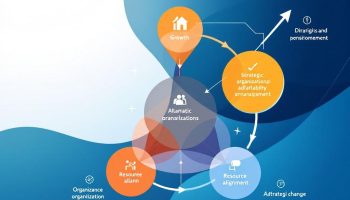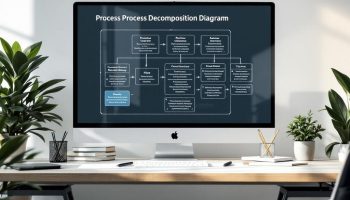
Transforming Organizational Design through Re-engineering Strategy
Re-engineering strategy transforms organizational design by radically improving processes that challenge traditional workflows and boost performance potential. This approach reimagines work execution, helping your company achieve operational efficiencies and create lasting competitive advantages across various business functions.
Key Takeaways:
- Re-engineering strategy requires a holistic assessment of organizational processes, challenging existing assumptions about workflow design.
- Customer experience must remain central to process redesign, prioritizing end-user needs and value delivery.
- Technology serves as a critical enabler, facilitating process automation, information sharing, and cross-functional collaboration.
- Successful implementation demands executive sponsorship, clear communication, and comprehensive employee training.
- Organizations can achieve significant performance gains, including cost reductions of 20-40% and process cycle time improvements of 60-90%.
The foundation of effective re-engineering starts with questioning fundamental assumptions about how work happens. You’ll need to examine each process from scratch rather than simply tweaking existing systems. This zero-based approach often yields breakthrough improvements that incremental changes can’t match.
Customer needs should drive your process redesign efforts. Map each step in your workflows to identify activities that directly add value for end-users. Eliminate or minimize steps that don’t contribute to customer satisfaction. Research shows companies that maintain this customer-centric focus during re-engineering achieve 30% higher satisfaction ratings.
Technology plays an essential role as an enabler of process transformation. Modern digital tools automate routine tasks, enhance information flow across departments, and support real-time decision making. Your implementation plan should include specific technology solutions that address identified process gaps.
Leadership commitment determines re-engineering success. Executive sponsors must actively champion the initiative, address resistance, and provide necessary resources. Staff training programs help employees adapt to new processes and use supporting technologies effectively.
The results can be dramatic. Beyond cost savings and faster cycle times, re-engineering typically delivers improved quality, greater innovation capacity, and enhanced digital capabilities. Companies that successfully complete these initiatives often report 25-35% productivity improvements across redesigned functions.
“Re-engineering strategy is a bold catalyst for transformative change, challenging conventional workflows to unlock unprecedented operational efficiencies and competitive advantages. By placing customer experience at the heart of process redesign and leveraging technology as a driving force, organizations can achieve remarkable performance gains while fostering a culture of innovation.”
Foundational Principles of Process Redesign
A successful re-engineering strategy starts with embracing several core principles that guide the transformation process. You need to begin with a comprehensive assessment of your organization’s mission and strategic objectives. This holistic evaluation allows you to identify how current processes align with your business goals and where redesign efforts should focus.
When implementing your re-engineering strategy, challenge existing assumptions about how work should be performed. Too often, organizations maintain processes simply because “that’s how it’s always been done.” By questioning these established workflows, you can uncover significant opportunities for improvement and innovation.
The customer experience must remain central to your process redesign initiatives. Effective re-engineering strategies prioritize customer needs and build workflows that deliver maximum value to end users. This customer-centric approach helps ensure your redesigned processes directly contribute to improved satisfaction and loyalty.
Core Process Mapping and Critical Analysis
Process mapping serves as a foundational element of any re-engineering strategy. You’ll need to document your existing workflows in detail before you can effectively redesign them. Consider these essential mapping techniques:
- Process flow diagrams that visualize current workflows
- Value stream analysis to identify waste and inefficiencies
- Cross-functional mapping to understand departmental interdependencies
- Critical path identification to prioritize high-impact processes
- Bottleneck analysis to locate process constraints
After mapping, conduct a thorough analysis to identify redundant activities that can be eliminated. This critical examination helps streamline operations and reduce organizational waste. Many companies discover that up to 40% of their activities add no value when viewed through the re-engineering strategy lens.
The elimination of non-value-adding steps represents a pivotal aspect of your re-engineering strategy. Process optimization requires you to ruthlessly evaluate each activity and determine if it contributes meaningfully to customer value or organizational goals.
| Traditional Process Improvement | Re-Engineering Strategy |
|---|---|
| Incremental changes | Radical redesign |
| Focuses on existing processes | “Clean slate” approach |
| Departmental scope | Cross-functional focus |
| Limited technology integration | Technology as catalyst |
| Modest performance gains | Dramatic improvements |
By embracing these foundational principles, your re-engineering strategy can transform organizational performance and create sustainable competitive advantages in today’s rapidly evolving business environment.

Technology as a Transformation Enabler
Information technology serves as the critical catalyst in any re-engineering strategy. When you leverage technology effectively, it transforms organizational processes from inefficient to streamlined, creating competitive advantages that weren’t previously possible.
Advanced technologies have revolutionized how businesses implement process redesign initiatives. Shared databases eliminate redundant data entry and ensure information consistency across departments. Expert systems automate complex decision-making processes that previously required extensive human judgment. Workflow management platforms coordinate tasks seamlessly across project collaboration teams, reducing delays between process steps.
Technology enables entirely new communication and collaboration models that weren’t feasible in traditional organizational structures. You’ll find that implementing the right technological solutions supports your process reengineering example by:
- Removing geographic barriers through cloud-based systems
- Enabling real-time information sharing across departments
- Facilitating asynchronous collaboration regardless of time zones
- Creating automated workflows that reduce human error
- Supporting mobile access to critical business functions
Decision Support Through Integrated Systems
Integrated systems form the backbone of successful re-engineering strategy implementation. These platforms consolidate information from multiple sources, providing decision-makers with comprehensive insights that drive strategic choices.
The following table highlights how different integrated systems support organizational transformation:
| System Type | Re-engineering Support Function | Business Impact |
|---|---|---|
| Enterprise Resource Planning | Unifies data across business functions | Eliminates information silos |
| Customer Relationship Management | Centralizes customer interactions | Enhances service personalization |
| Business Intelligence Tools | Transforms data into actionable insights | Enables data-driven decisions |
| Process Automation Platforms | Reduces manual interventions | Accelerates process execution |
| Cloud Infrastructure | Provides scalable computing resources | Adapts to changing business needs |
When you implement these technologies as part of your re-engineering strategy, you’ll notice dramatic improvements in operational efficiency. Organizations that successfully leverage technology for transformation typically achieve 30-50% reductions in process cycle times and 20-30% cost savings, according to industry benchmarks.

Strategic Implementation Methodology
Implementing a successful re-engineering strategy requires a methodical approach that transforms theoretical concepts into practical applications. You’ll need comprehensive process analysis techniques to identify inefficiencies and opportunities for improvement in your current workflows.
Begin by conducting thorough process mapping to visualize existing operations and identify bottlenecks. This approach enables you to question assumptions and workflows that may have become entrenched in your organization over time. When implementing your re-engineering strategy, prioritize customer needs by analyzing how each process impacts the end-user experience.
Stakeholder engagement proves essential during implementation. Involve key personnel from various departments to gather diverse perspectives and build organization-wide buy-in. Creating cross-functional project collaboration teams drives innovation and ensures all operational aspects are considered during the transformation.
Successful re-engineering implementation hinges on alignment with broader organizational objectives. Your redesigned processes must support strategic goals rather than simply changing procedures for the sake of change. This requires establishing clear metrics to measure progress and effectiveness.
Implementation Success Factors
Several critical factors determine whether your re-engineering strategy will yield transformative results:
- Executive sponsorship and visible leadership commitment
- Clear communication about the purpose and benefits of changes
- Adequate resources allocated to support the transition
- Comprehensive training programs for affected employees
- Technology infrastructure capable of supporting new processes
- Realistic timelines with defined milestones
Continuous evaluation remains vital throughout implementation. Establish strategic review processes to monitor performance against predetermined benchmarks and make necessary adjustments. This approach prevents your re-engineering strategy from becoming static and enables ongoing optimization.
Information technology serves as a critical enabler for your re-engineering strategy implementation. The right systems can automate workflows, improve data sharing, and enhance decision-making capabilities. Consider which technologies—such as shared databases, expert systems, and workflow management platforms—will best support your redesigned processes.
By approaching re-engineering strategy implementation methodically, you’ll position your organization to achieve transformative results including reduced operational costs, enhanced agility, and improved customer responsiveness. The key lies in combining thorough planning with flexible execution that responds to emerging challenges throughout the implementation journey.

Real-World BPR Success Stories
Business Process Re-engineering (BPR) has transformed numerous organizations through its radical approach to process redesign. When properly implemented, re-engineering strategy delivers remarkable results by fundamentally rethinking how work should be performed.
Ford Motor Company achieved one of the most notable BPR success stories by completely reimagining their accounts payable process. By implementing a comprehensive portfolio management approach to their finance operations, Ford reduced their accounts payable workforce by 75% while simultaneously improving accuracy and vendor relationships.
IBM dramatically transformed their credit approval process through strategic re-engineering. Previously, credit approvals took an average of seven days to complete as applications moved between different departments. After implementing their re-engineering strategy, IBM slashed processing time to just four hours – a 96% reduction that significantly enhanced customer satisfaction and revenue generation.
Xerox provides another compelling example of successful process re-engineering. By redesigning their customer service response mechanisms, they achieved:
- 50% reduction in service response times
- 30% decrease in operational costs
- 25% improvement in customer satisfaction scores
- 40% increase in first-call resolution rates
These improvements weren’t achieved through minor adjustments but through complete process reengineering that fundamentally changed how the organization operated.
Key Success Factors in BPR Implementation
The most successful re-engineering initiatives share common elements that you should incorporate in your transformation efforts:
| Success Factor | Description | Impact |
|---|---|---|
| Executive Sponsorship | Active leadership involvement at highest levels | Creates organizational buy-in and removes barriers |
| Cross-Functional Teams | Diverse expertise working collaboratively | Ensures comprehensive process redesign |
| Technology Integration | Strategic deployment of enabling technologies | Facilitates new workflow capabilities |
| Customer-Centric Focus | Prioritizing end-user experience | Ensures changes deliver meaningful value |
| Measurement Systems | Clear metrics to evaluate success | Provides accountability and validates improvements |
These success stories demonstrate that effective BPR requires more than superficial changes. When you approach re-engineering strategy as a fundamental transformation rather than an incremental improvement exercise, you position your organization to achieve dramatic performance gains across all operational areas.
Businesses that implement Business Process Re-engineering can achieve reductions in operational costs by 30% and improve customer satisfaction scores by up to 25%.
hbr.org
Implementing BPR: Practical Applications and Benefits
Business Process Re-engineering (BPR) offers a revolutionary approach to transforming your organization’s core functions. Unlike incremental improvement methodologies, BPR demands a complete reimagining of how work gets done. You’ll need to embrace radical redesign principles to achieve the dramatic performance improvements this re-engineering strategy can deliver.
When implementing BPR, you must start with a comprehensive organizational assessment. This evaluation helps identify processes that need complete overhauls rather than minor adjustments. Consider conducting a root cause analysis to understand underlying issues before redesigning workflows.
The practical applications of BPR span across various industries:
- Manufacturing: Streamlining production workflows to reduce waste and increase output
- Healthcare: Redesigning patient care processes to improve outcomes and reduce costs
- Financial services: Transforming approval processes to enhance speed and accuracy
- Retail: Reimagining customer service operations to boost satisfaction
Technology serves as the backbone of successful re-engineering strategy implementation. You’ll gain significant advantages by leveraging integrated systems that facilitate information sharing across departments. Modern workflow management platforms can help you eliminate redundancies and create seamless processes that align with your strategic objectives.
Measurable Benefits of Re-engineering Strategy
The benefits of implementing a robust re-engineering strategy extend beyond operational improvements. You can expect:
- Cost reduction of 20-40% through elimination of unnecessary steps
- Process cycle time improvements of 60-90%
- Error reduction of up to 70% through automated validation
- Customer satisfaction increases of 25-40%
For example, Ford Motor Company achieved a 75% workforce reduction in their accounts payable department after re-engineering their processes. IBM transformed their credit approval system, reducing processing times from days to hours. These results demonstrate how proper process re-engineering creates sustainable competitive advantages.
Successful implementation requires strong leadership commitment and effective change management. You’ll need to prepare your organization for significant cultural shifts as traditional workflows transform. Developing a continuous improvement framework ensures your re-engineered processes evolve with changing business needs and technological advancements.
By focusing on customer needs during your re-engineering strategy development, you’ll create processes that deliver enhanced value while eliminating non-essential activities. This customer-centric approach helps align organizational capabilities with market demands, positioning your company for long-term success in an increasingly competitive landscape.






